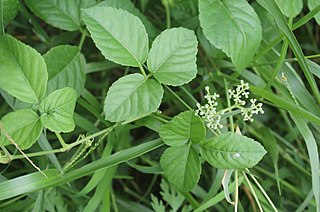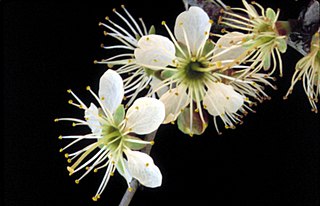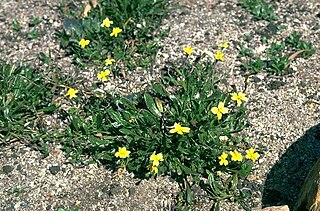
Cissus is a genus of approximately 350 species of lianas in the grape family (Vitaceae). They have a cosmopolitan distribution, though the majority are to be found in the tropics.

Gnathothlibus erotus, the white-brow hawkmoth, is a moth of the family Sphingidae. The species was first described by Pieter Cramer in 1777.

Theretra latreillii, the pale brown hawk moth, is a moth of the family Sphingidae described by William Sharp Macleay in 1826. It is found in most of Asia, including Borneo, China, Hong Kong, the Philippines, Taiwan and also throughout the tropical and temperate regions of Australia.

The genus Cayratia comprises approximately 45 species of plants, some of which have utility value to people. It is found in tropical and subtropical areas of Asia, Africa, Australia, and islands of the Pacific Ocean.

Hirschfeldia incana is a species of flowering plant in the mustard family known by many common names, including shortpod mustard, buchanweed, hoary mustard and Mediterranean mustard. It is the only species in the monotypic genus Hirschfeldia, which is closely related to Brassica. The species is native to the Mediterranean Basin but it can be found in many parts of the world as an introduced species and often a very abundant noxious weed. This mustard is very similar in appearance to black mustard, but is generally shorter. It forms a wide basal rosette of lobed leaves which lie flat on the ground, and it keeps its leaves while flowering. Its stem and foliage have soft white hairs. Unlike black mustard, H. incana is a perennial plant.

Cayratia acris is a species of plant native to Australia and Papua New Guinea.

Cayratia japonica is a species of herbaceous plant native to Australia and Asia. It is used as a traditional Chinese medicine to relieve swelling and heat, and to enhance diuresis and detoxification.
Cayratia debilis is a species of flowering plant in the Vitaceae family. It is native to equatorial Africa. It has herbaceous or slightly woody vines, with 5-foliate leaves and greenish-white or yellow flowers. Its stem, leaves and sap are used in herbal medicine in various African countries, and the leaves are eaten as a vegetable on the island of Bioko. Its fruits are inedible, although are fed to poultry in the Central African Republic to protect from influenza and coccidiosis.

Cayratia trifolia commonly known as bush Grape, fox-grape, three-leaved wild vine or threeleaf cayratia is a species of liana plant native to Australia and Asia. It has black-colored berries, and its leaves contain several flavonoids, such as cyanidin and delphinidin. Hydrocyanic acid is present in the stem, leaves and roots.

Theretra japonica is a moth of the family Sphingidae first described by Jean Baptiste Boisduval in 1869.

Cayratia clematidea, known as the native grape or slender grape, is a common Australian vine in the grape family. Growing in or on the edges of rainforest, from the Shoalhaven River gorges north to Queensland. Tendrils form opposite the leaf.
The Junqueira cow is a cattle breed from Brazil that is the result of crosses between Caracu and other Brazilian varieties. It is of the subspecies Bos taurus ibericus. The breed has been raised since the 18th century, but only about 100 remained in 2005. However, it has been cloned in the laboratory by the Brazilian Agricultural Research Corporation.

Prunus geniculata is a rare species of plum known by the common name scrub plum. It is endemic to Florida in the United States, where it occurs on the Lake Wales Ridge in the central ridges of the peninsula. It is threatened by the loss of its habitat and is a federally listed endangered species of the United States.

Thalia geniculata, the bent alligator-flag, arrowroot, or fire-flag, is a plant species widespread across tropical Africa and much of the Americas.

Cayratia mollissima is an evergreen species of climber plant found in Indochina, Malaysia and the Philippines. It has 3-foliate leaves with small bluish green flowers and produces pinkish white berries, and usually grows at forest margins.
Mabrya geniculata is a mat-forming herbaceous perennial native to the Mexican states of Sonora and Chihuahua. It has pale yellow tubular flowers. It was first described in 1894 by Benjamin L. Robinson and Merritt L. Fernald in the genus Maurandya and transferred to Mabrya by Wayne J. Elisens in 1985.
Clausicella geniculata is a species of bristle fly in the family Tachinidae. It is found in North America.
Curvularia geniculata is a fast-growing anamorphic fungus in the division Ascomycota, most commonly found in soil, especially in areas of warmer climates. The fungus is a pathogen, mainly causing plant and animal infections, and rarely causing human infections. C. geniculata is characterized by its curved conidia, which has a dark brown centre and pale tapered tips, and produces anti-fungal compounds called Curvularides A-E.

Goodenia geniculata, commonly known as bent goodenia or native primrose, is a species of flowering plant in the family Goodeniaceae and is endemic to south-eastern Australia. It is a low-lying to ascending herb with linear to lance-shaped, often toothed leaves at the base of the plant and racemes of yellow flowers with hairy backs.













